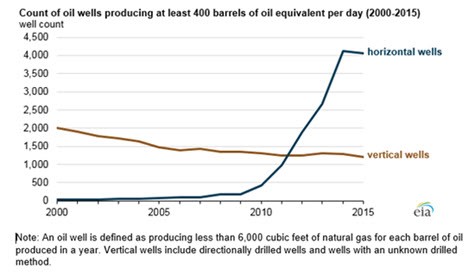WASHINGTON, Nov. 17, 2016 - Oil wells drilled horizontally through hydrocarbon-bearing formations are often among the highest producing wells in the U.S., according to data from the Energy Information Administration.
Modern horizontal drilling achieved commercial success in the 1980s and has become more common recently as drilling techniques improved, EIA says.
Geologic formations are almost always much greater in horizontal extent than they are in vertical thickness, EIA notes. For this reason, more oil-bearing rock is exposed for production in horizontal drilling than in vertical drilling.
EIA says that horizontal wells are
often completed in combination with hydraulic fracturing to maximize production
along the exposed rock formation.
In 2015 the data show that nearly 77 percent of the most prolific U.S. oil wells, or those producing more than 400 barrels of oil equivalent (BOE) per day, were horizontally drilled wells.
For about 85,000 moderate-rate wells producing in 2015, defined as more than 15 BOE per day and up to 400 BOE per day, 42 percent were drilled horizontally.
The agency says that of the approximately 370,000 lowest-rate, marginal oil wells in 2015, also known as stripper wells, only about 2 percent were horizontal wells.
#30
For more news, go to: www.Agri-Pulse.com

